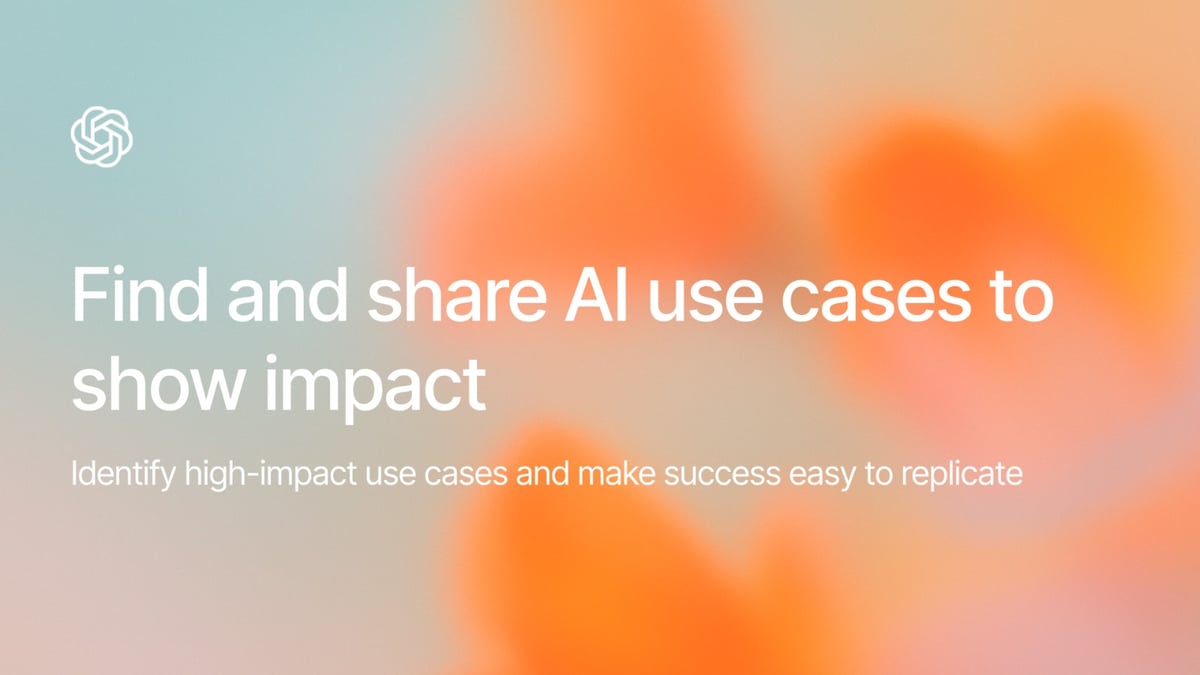Article
August 5, 2025 · Last updated on August 7, 2025
Find and share AI use cases to show impact

# Champions
# Use Cases
# Telling Value and ROI Story
Identify high-impact use cases and make success easy to replicate

Find and share AI use cases to show impact
In your role as a Champion, you’ve already sparked ideas through Prompt Challenges and turned the most promising workflows into GPTs. With ideas surfaced and tools built, the focus now shifts to validating where AI is making the biggest difference. The next step is proving the value of those efforts — showing where AI delivers measurable benefits and making those examples easy for others to adopt.
In AI adoption, the path typically moves from identifying workflows → testing in context → validating use cases → sharing and embedding those use cases. A workflow is simply the process your team follows to complete a task. A use case is a proven example of AI applied to that workflow that delivers measurable results and can be repeated by others.
Moving from workflows to use cases turns earlier experiments into trusted proof that builds credibility, earns buy-in, and gives other teams the confidence to try AI in their own work. Strong AI programs are built on proof: a set of use cases that consistently deliver better speed, clarity, or consistency. They start as raw ideas from workshops, Prompt Challenges, or team experiments, then get refined, measured, and turned into repeatable assets others can trust.
AI adoption becomes real when use cases demonstrate impact you can feel. A good use case answers:
- What changed? What did we do better or faster?
- What’s the value? How much time or effort did we save?
- Can we repeat it? Can others pick it up and adapt it to their workflows?
As a Champion, your role is to spot these high-impact examples, make them visible, and package them as repeatable assets, not just one-off stories, but solutions your team can pick up and use right away.
What we're seeing
Across organizations, several patterns stand out:
- Strong use cases beat abstract features: Adoption happens more naturally when AI is applied to specific, real workflows like summarizing customer insights, drafting high-quality reports, or preparing leadership updates.
- Workshops fuel discovery: Use case workshops and Prompt Challenges create a focused funnel, surfacing the best starting points for repeatable wins.
- Champions amplify value: Internal Champions move examples from experiments to reusable workflows, pairing them with metrics like time saved or improved quality to show impact leadership can recognize.
- Repositories make proven ideas easy to find: The best programs don’t just talk about use cases; they collect them, tag them, and build lightweight hubs or GPTs so teams can discover what works and adapt it to their needs.
These patterns reinforce the best-practice sequence: start by identifying workflows, experiment and refine with GPTs, and then validate the strongest results as documented use cases.
What makes a strong use case
Not every AI experiment qualifies as a use case. A strong use case is tied directly to a business challenge and demonstrates clear, repeatable value that others can trust. In other words, it’s more than an interesting idea — it’s proof that AI is making a meaningful difference.
A strong use case has:
- A specific workflow: The task is clearly defined (ex: summarizing weekly updates, drafting RFP responses).
- A measurable change: There’s evidence of improvement, such as time saved, steps reduced, or higher-quality output.
- Repeatability: A colleague can follow the same steps and achieve similar results without reinventing the process.
- Alignment to priorities It connects to team or organizational goals, such as faster reporting, improved communication, or more efficient knowledge-sharing.
Meeting these criteria is what elevates an AI application from “interesting experiment” to “proven example worth sharing” the kind that builds credibility, earns leadership attention, and encourages adoption across teams.
Champion-led use case workshops
Workshops are one of the most effective ways to move from scattered experimentation to structured use cases. They give teams dedicated time to brainstorm, test, and validate where AI delivers measurable improvements.
How Champions run workshops
- Set the Focus: Choose 2–3 workflows your team already spends time on (ex: meeting recaps, onboarding templates).
- Collect Examples: Ask participants to bring real work: notes, drafts, or repetitive tasks they’d like to improve.
- Live Testing: Break into small groups to apply AI to those tasks, trying different prompts or approaches.
- Document the Wins: Capture clear before and after comparisons:
- What changed?
- What’s the value (time saved, better clarity)?
- Can it be repeated?
- Prioritize: Select the top 2–3 workflows worth developing into formal use cases.
Champion Tip: Start with a single workshop for one team or department. Once you have 3–5 validated use cases, share them broadly and encourage other teams to replicate the session. This keeps momentum focused on the most promising, high-impact examples.
Sharing and scaling use cases
A great use case is only valuable if others can find it, trust it, and apply it. Champions play a critical role in amplifying adoption by making success visible and easy to replicate. When use cases are shared well, they move from isolated wins to organization-wide improvements.
How to share
- Tell the story: Use the simple “Task → Before → After → Impact” format to make the value clear at a glance.
- Show examples: Share prompts, screenshots, or short demo clips that others can copy directly into their work.
- Embed in the flow of work: Post examples in team Slack channels, highlight them during meetings, or add them to onboarding materials so they appear right when someone needs them.
- Celebrate wins: Recognize the people and teams who contributed a strong use case. Public recognition builds momentum and encourages others to share their own.
The more friction you remove from finding and using a proven example, the faster adoption grows. Place use cases where work happens, and provide everything someone needs to replicate the result.
Next steps for Champions
Replicating results is only possible when Champions actively close the loop — moving from identifying strong use cases to making them easy for others to apply.
- Run a Use Case Workshop: Pick a team or department and identify 3–5 tasks to test.
- Document and Share: Turn the top workflows into concise use case stories with clear metrics.
- Launch a Repository or GPT: Create a central home for these examples so they’re easy to find and reuse.
- Measure Signals: Track time saved, reuse patterns, and mentions of use cases in team updates to demonstrate impact.
Keep the momentum going by reviewing your repository or GPT regularly, refreshing outdated examples, and spotlighting new ones during team meetings or in your Champion Network (which you'll learn about next).
Final thoughts
Use cases are the heartbeat of AI adoption. They turn abstract potential into tangible impact, showing teams how AI makes real work faster, easier, and better. A single, well-documented use case can spark curiosity, build confidence, and create momentum across a team.
As a Champion, your influence grows when you curate and amplify these examples. You’ve already generated ideas through prompt challenges and built tools with GPTs, now is the time to prove which ones deliver the most value. Start small, focus on workflows that matter, and let measurable wins speak for themselves.
When you capture and share not just what AI can do, but how it changes the way your team works, you shift AI from being a tool people try to a capability they rely on. Your goal isn’t to create a long list of experiments, it’s to find the few examples that truly move the needle, and make them easy for everyone to use and build on.
Table Of Contents
Popular
Resource
The AI Champion role
Resource
Use Case Showcase Playbook

